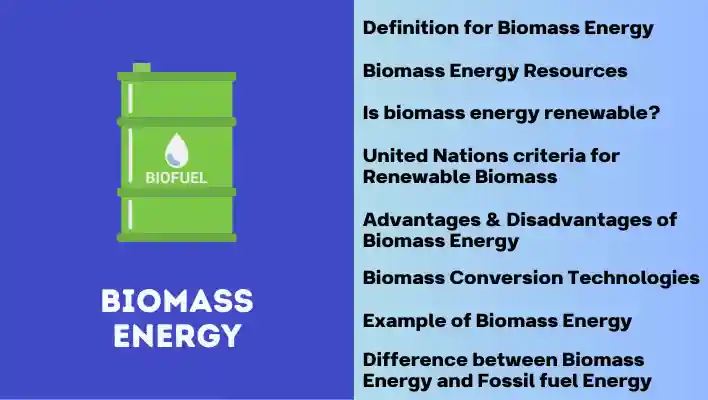Before the discovery of fossil fuels such as petroleum products, coal, and natural gas, biomass was the main source of energy for heating and cooking.
Now, Biomass energy stands as one of the world’s leading renewable energy options. Unlike fossil fuels, biomass energy use has a net CO2 emission close to zero, as the CO2 released can theoretically be reabsorbed during biomass growth. This characteristic makes bioenergy an extremely valuable and efficiently utilized renewable energy source.
This article offers a comprehensive overview of biomass energy sources, conversion technologies, advantages, and more.
Also Read: Explained | Top 7 Solar Energy technologies
Definition for Biomass Energy
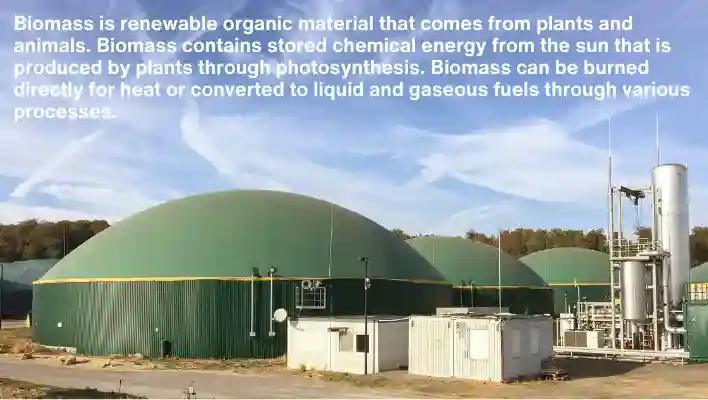
Biomass refers to organic matter derived from plants, trees, algae and crops that utilize photosynthesis to capture and store solar energy.
It includes living things and recently dead matter that we can use for fuel or making chemicals. It doesn’t count old organic fossil fuels like coal or oil that took millions of years to form. Biomass comes from plants, animals, or both.
Biomass energy is the conversion of these plants and other organic matter into useful energy like heat, electricity, or liquid fuels.
This type of energy is produced by cultivating specific energy crops, also referred to as biomass crops. These include non-food plants like Miscanthus, Jatropha, Elephant Grass, and Switchgrass.
Additionally, energy can be derived from residues generated during the processing of crops like rapeseed, sunflower, corn and sugar cane, as well as from by-products such as pulp and paper from the wood industry.
Sometimes, instead of using biomass directly, we turn it into another medium that can be used as energy, like charcoal, ethanol or producer gas, through various conversion processes like pyrolysis or gasification.
Also Read: Wind Energy 101: Explore the Basics of a Sustainable Future
Biomass Energy Resources

1. Agricultural crops and residues: In this category, we have things like wheat, rice, rapeseed, sunflower, soybeans, corn, sugarcane, and sugar beets. These can all be used to make energy. For example, we can turn the sugar from corn, sugar beets, and sugarcane into ethanol, a type of fuel. And crops like rapeseed, sunflower, and soybeans can be made into biodiesel.
2. Forestry Crops and Residues: Forest biomass refers to organic material derived from forests, including trees, shrubs, bushes, and other vegetation. This biomass can be used for various purposes, such as energy production, including heat and electricity generation, as well as for producing biofuels and other bioproducts. Forest biomass is a renewable resource, as trees and other vegetation can be replanted and grown to replace what is harvested.
3. Animal waste: Animal residue includes animal manure, such as from livestock like cattle, pigs, poultry, and other farm animals. Animal residue biomass can also include by-products from slaughterhouses and processing facilities, such as blood, bones, and fat.
This type of biomass can be converted into renewable energy through processes like anaerobic digestion, where microorganisms break down the organic matter in the absence of oxygen to produce biogas, a mixture of methane and carbon dioxide. Additionally, animal residue biomass can be composted or used as fertilizer to improve soil health and fertility in agriculture.
4. Industrial residues: Industrial residues are organic material that is left over from industrial processes and can be utilized for various purposes, particularly energy production. This biomass includes residues from manufacturing, processing, and other industrial activities.
Examples of industrial residue biomass include wood chips, sawdust, bark, and other by-products from the forestry and wood processing industries, as well as agricultural residues like straw, husks, and shells generated from food and beverage processing.
These residues can be converted into bioenergy through processes such as combustion, gasification, or anaerobic digestion, providing a sustainable and renewable source of energy while also reducing waste and environmental impact.
5. Sewage sludge: Biomass from sewage sludge refers to organic material extracted from wastewater during the sewage treatment process. Sewage sludge is composed of organic matter, including human waste, as well as other organic materials that are removed during the treatment of sewage.
6. Municipal Solid Waste: Municipal Solid Waste (MSW) can be considered biomass because it primarily consists of organic materials derived from household, commercial, and institutional sources. These organic materials include food waste, paper, cardboard, yard trimmings, and other biodegradable materials.
Technologies such as anaerobic digestion and landfill gas recovery can capture methane emissions from decomposing organic waste and convert it into biogas, which can be used to generate electricity, heat, or transportation fuels.
Additionally, MSW can be processed through thermal conversion technologies like incineration or gasification to produce heat and electricity.
7. Marine biomass: Marine biomass refers to organic material derived from marine organisms, including plants, animals, and microorganisms, that inhabit oceans, seas, and other bodies of water. This biomass can encompass a wide range of marine life, such as algae, seaweed, plankton, fish, shellfish, and other aquatic organisms.
It holds promise as a renewable energy source. Algae, for instance, can be converted into biofuels such as biodiesel or ethanol through processes like fermentation or thermochemical conversion. Additionally, seaweed can be utilized for the production of bioethanol, biogas, or even as a feed-stock for thermal conversion technologies like pyrolysis or gasification.
8. Energy Crops: Energy crops are specific types of plants that are grown specifically for their use as a renewable energy source. These crops are cultivated to produce biomass, which can be converted into various forms of energy, such as electricity, heat, or biofuels.
Energy crops are typically chosen for their high biomass yield, fast growth rates, and suitability for cultivation on marginal or degraded land. Examples of energy crops include: Miscanthus, Switchgrass, Willow and Poplar, Short Rotation Coppice (SRC) species, Industrial Hemp and Oil-seed crops.
Also Read: Guide to Geothermal Energy | How Earth’s Power is Harnessed?
Is biomass Energy Renewable?

Biomass obtained using sustainable methods is categorized as a renewable energy source. It includes solids as well as gases and liquid biomass derived from the decomposition of organic materials that are not fossils and can break down in natural ways (biodegradable).
Since biomass comes from organic matter, it naturally absorbs carbon dioxide (CO2) from the air while it’s growing. So, when we burn biomass for heat or electricity generation, it releases CO2, but it’s not adding new CO2 to the air because it already absorbed it while growing.
This process balances the CO2 around the world and doesn’t aggravate global warming. That’s why biomass energy is renewable and greenhouse gas neutral.
But there is catch, refer the below United Nations defines renewable biomass.
United Nations criteria for Renewable Biomass
According to the United Nations Framework Convention on Climate Change (UNFCCC), biomass is deemed renewable if it meets specific criteria set by the Clean Development Mechanism (CDM). These conditions, established by the CDM, aim to ensure that the use of biomass does not result in a net reduction of carbon stocks or cause harm to the environment.
CDM says Biomass is “renewable” if one of the following five conditions are met:
- Forest Biomass: Biomass sourced from forested regions must be preserved as forests. Sustainable management methods should be adopted to safeguard carbon stores within these lands, preventing a gradual decline over time. Also compliance with local or national forestry and environmental protection laws is mandatory.
- Woody Biomass from Croplands/Grasslands: Woody biomass from croplands or grasslands must remain as croplands/grasslands or be reverted to forest. Sustainable management practices must be in place to prevent systematic decreases in carbon stocks over time. Compliance with relevant forestry, agriculture, and nature conservation regulations is mandatory.
- Non-woody Biomass from Croplands/Grasslands: Similar to condition 2, non-woody biomass from croplands/grasslands must meet the same criteria.
- Biomass Residue: Biomass residues, such as bagasse from sugar production, can be considered renewable if their use does not result in a decrease in carbon pools, such as dead wood, litter, or soil organic carbon. The residue’s utilization should not affect the original carbon stocks on the land where it originated.
- Non-fossil Fraction of Waste: Biomass from non-fossil parts of industrial or municipal waste is renewable if it doesn’t break the mentioned rules.
In summary, biomass is classified as renewable if it meets one of these conditions. Otherwise, it’s considered non-renewable. These criteria aim to ensure that biomass utilization contributes to sustainable land management and does not deplete carbon stocks or violate environmental regulations.
Also Read: Renewable Energy | A comprehensive explanation
Biomass Conversion Technologies
Biomass can be transformed into various kinds of energy using different methods. Many things affect how we do this, like the type of biomass, how much there is, its features, and environmental regulations. However, the choice of conversion method usually depends on the specific energy needed and the type of biomass we have on hand.
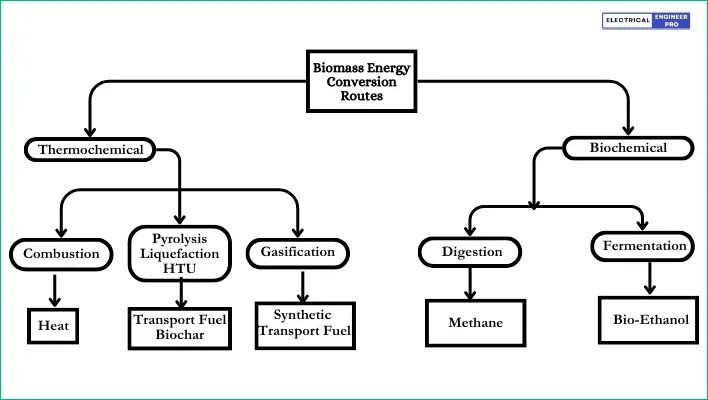
The main Biomass conversion routes are,
- Thermochemical Conversion
- Biochemical Conversion
Thermochemical Conversion
In thermochemical conversion, the whole biomass is turned into gases, which can then be made into the chemicals we want or used right away. Making thermal energy is the main reason for this conversion method, which has four main ways:
- Combustion
- Pyrolysis
- Gasification
- Liquefaction
Combustion
The process of combustion has been a widely used method of converting biomass since the early days of human civilization.
Combustion involves burning biomass material in the presence of excess air. This rapid chemical reaction between the oxygen in the air and the combustible elements in biomass generates heat.
Chemically, combustion is an exothermic reaction between oxygen and the hydrocarbons in biomass, resulting in the production of two main stable compounds: water vapor (H2O) and carbon dioxide (CO2). This release of heat from the reaction is currently the largest source of energy consumption for humans, making up over 90% of the energy derived from biomass.
Direct combustion of biomass releases the chemical energy stored in the fuel as heat. Waste from forest products is commonly used to generate heat for processes in industries like pulp and paper production. In many developing countries, biomass combustion is traditionally used for activities such as cooking, brick making, tea drying, and charcoal production.
Additionally, biomass combustion is utilized to generate steam for industrial processes and power applications.
Pyrolysis
Pyrolysis refers to the thermal breakdown of biomass fuel without oxygen. During this process, biomass transforms into various products including char, fuel gas and a valuable liquid called “bio-oil.”
Recent advancements in pyrolysis technology have enhanced the yield of bio-oil, making it suitable for use as both a chemical feed-stock and fuel oil.
Pyrolysis offers several advantages. It converts solid materials into gases and vapors. These gases can be burned in boilers, gas turbines, and reciprocating engines, enhancing fuel flexibility and security.
Additionally, capturing and burning methane and carbon monoxide in syngas utilizes their energy while producing less potent greenhouse gases like carbon dioxide, thus offsetting fossil fuel energy production.
However, pyrolysis and gasification have drawbacks. They require heat input to drive the chemical reactions producing syngas, necessitating the use of some fuel for syngas generation.
Gasification
Biomass gasification involves the thermal breakdown of material in a controlled environment with little air to generate combustible fuel gases.
The resulting product of biomass gasification is a fuel gas primarily composed of carbon monoxide and hydrogen. Due to the substantial presence of nitrogen and carbon dioxide, the gas possesses a low heat value and is referred to as ‘producer gas.’
On the other hand, when oxygen is utilized in the gasifier instead of air, the resulting product gas, devoid of nitrogen, consists mainly of carbon monoxide and hydrogen, termed medium heat-value gas or synthesis gas (syngas). The term “synthesis gas” typically denotes a mixture of hydrogen and carbon monoxide in proportions suitable for various chemical synthesis reactions.
Both low- and medium-heat-value gases produced from biomass gasification can serve as direct fuels across various energy-consuming sectors. Low heat-value gas can act as a supplementary fuel for industrial boilers, internal combustion engines, and to provide mechanical and electrical power to small-scale industries and agricultural equipment.
On the other hand, medium heat-value gas (syngas) can serve as a precursor for liquid fuels and chemicals.
Liquefaction
Liquefaction in biomass technology refers to the process of converting solid biomass materials into liquid fuels or chemicals. This process involves breaking down the complex organic molecules present in biomass, such as cellulose, hemicellulose, and lignin, into simpler hydrocarbons that can be used as biofuels or as feed-stocks for the production of various chemicals.
There are several methods for liquefying biomass, including:
- Thermochemical Liquefaction
- Biochemical Liquefaction
- Hydrothermal Liquefaction
The liquid products obtained from biomass liquefaction can be further refined to produce biofuels such as bio-oil, biodiesel, or ethanol, which can be used as alternatives to fossil fuels in transportation and other applications. Additionally, these liquid products can serve as precursors for the production of various chemicals and materials, offering a renewable and sustainable alternative to petroleum-based products.
Biochemical Conversion
Biochemical biomass conversion technologies convert biomass into various products and intermediates by employing different microorganisms or enzymes. This process offers a versatile platform for obtaining fuels and chemicals like biogas, hydrogen, ethanol, butanol, acetone, and diverse organic acids. Its primary aim is to develop products capable of substituting petroleum-based and grain-derived alternatives.
Anaerobic Digestion
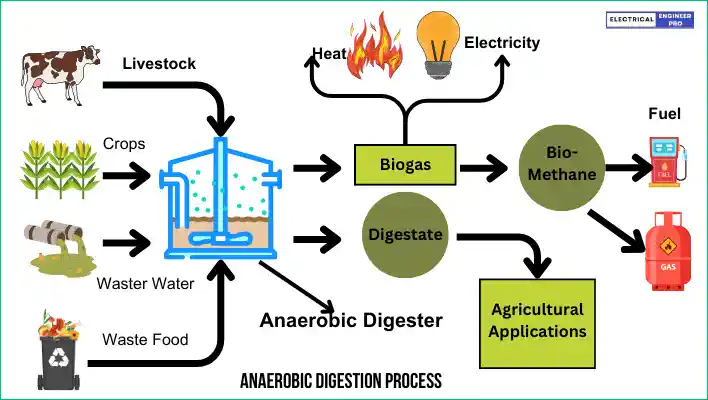
Anaerobic digestion is a natural biological process where organic matter breaks down in the absence of oxygen, yielding a blend of methane and carbon dioxide known as biogas. This process occurs in various environments like freshwater and marine sediments, flooded soils, and landfills, as well as in industrial and municipal waste treatment facilities. Common organic sources used to generate methane in such setups include crop residues, animal manure, food scraps, and sewage.
Biogas, with its high methane content (typically 50-75%), is combustible, producing a distinct deep blue flame. Additionally, the byproducts of anaerobic digestion, called digestates, are nutrient-rich and can be utilized as fertilizer in agricultural applications.
Fermentation
Fermentation is a biological process which transforms fermentable sugar compounds into a diluted ethanol solution through specialized strains of yeast. This resulting alcohol mixture is known as “beer” and undergoes heating to extract the alcohol via distillation. Further distillation, with the help of chemical solvents, yields fuel-grade ethanol of over 99 percent purity.
Commercially, fermentation is widely employed on a large scale across various countries to generate ethanol from sugar crops (such as sugar cane and sugar beet) as well as starch crops (like maize and wheat).
Further, fermentation plays a vital role in biorefineries, paving the way for a variety of products that can replace fossil fuel hydrocarbons in standard refineries. Researchers are hard at work developing technologies to make fermentation possible with tougher materials like wood chips, using methods such as pre-treatment or finding just the right enzymes to get the job done.
Extraction
Extraction, also referred to as physio-chemical conversion, is a mechanical process employed to extract oil from the seeds of diverse biomass crops like oil-seed rape (OSR) and linseed.
This process yields a liquid fuel that can undergo an additional stage called esterification, transforming the oil into fatty acid methyl ester, commonly known as biodiesel. Apart from oil, the process also generates a solid residue or “cake,” which finds utility as animal fodder. The primary application of biodiesel is as a liquid transport fuel, frequently blended with petroleum-derived diesel.
Also Read: 8 Latest Trends in Electrical Engineering
Advantages of Biomass Energy
- Reduces greenhouse gas (GHG) emissions: Biomass energy contributes to mitigating climate change by reducing the emission of greenhouse gases, such as carbon dioxide, methane, and nitrous oxide, compared to fossil fuels.
- Improves energy security: By diversifying the energy supply and reducing reliance on fluctuating global energy markets, biomass energy enhances energy security for countries.
- Economic opportunities: Biomass energy generation creates jobs and income, particularly benefiting rural economies where forestry and agricultural industries thrive, thus fostering economic development.
- Complements waste management: Biomass energy complements efforts to improve waste management by utilizing agricultural and forestry residues, as well as municipal solid waste, for energy production, thereby reducing the burden on landfills and improving air and water quality.
- Enhances modern energy access: Biomass energy helps in extending modern energy access to those without it, particularly the 2.7 billion people lacking access to heating, cooking, and electricity, thereby addressing energy poverty.
Disadvantages of Biomass Energy
- Land intensive: Biomass energy requires a significant amount of land for cultivation and harvesting, making it a dispersed and land-intensive energy source, which could compete with food production or natural habitats.
- Low energy density: Biomass materials typically have low energy density compared to fossil fuels, necessitating large quantities for energy production and increasing transportation costs.
- Labour intensive and costly: The collection and processing of biomass for commercial application are labor-intensive and costly, especially when large quantities are required, making it economically challenging compared to other energy sources.
- Limited capacity: Biomass energy capacity is constrained by the availability of biomass feed-stock, making it unsuitable for varying loads and not feasible for installation in all locations.
- Not suitable for all locations: Biomass energy generation may not be feasible or practical in all geographic locations due to factors such as land availability, climate, and infrastructure constraints.
Example of Biomass Energy
Biomass energy refers to all fuels and energy products that can be produced from biological resources. Collectively, these resources are called “biomass.”
Biomass energy can be sourced from fuels classified as,
- Biomass Energy Crops
- Biomass Resources
Biomass Energy Crops
Biomass energy crops specifically refer to plants that are grown with the primary intention of being used as a source of biomass for energy production.
These crops undergo cultivation and management practices aimed at maximizing their biomass yield, including techniques such as fertilization, irrigation, and selective breeding.
Examples of biomass energy crops encompass both terrestrial plants like switch-grass, willow, miscanthus, sugarcane, and certain fast-growing trees, as well as aquatic and marine plants such as hyacinth, salvinia, duckweed, kelp, seaweed, and algae.
The following chart illustrates typical biomass energy crop materials, conversion processes, and resultant energy products, serving as direct or indirect substitutes for petroleum-derived fuels.

Biomass Resources
Biomass resources encompass a broader range of organic materials that can be used as a source of biomass for energy production. Unlike biomass energy crops, biomass resources are not necessarily cultivated specifically for energy purposes; they may be residues or waste products from other processes or industries.
It includes not only dedicated energy crops but also agricultural residues like crop stalks and straw, forestry residues such as branches and bark, organic waste like food waste, animal manure, and sewage, and certain types of algae.
Biomass resources may also include byproducts from industries, such as sawdust from lumber mills or leftover materials from food processing.
The chart below illustrates typical biomass resources, conversion processes, and resultant energy products, serving as direct or indirect substitutes for petroleum-derived fuels.
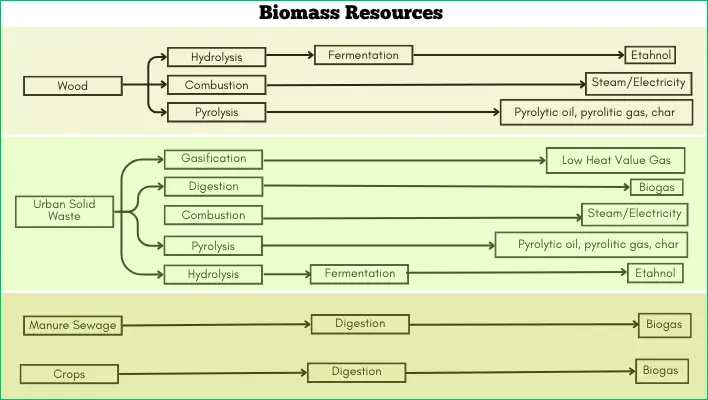
Difference Between Biomass Energy And Fossil Fuel Energy
| Biomass Energy | Fossil Fuel Energy | |
| Source | Derived from organic materials like plants, agricultural residues and waste. | Derived from fossilized organic matter such as coal, oil, and natural gas. |
| Renewability | Considered Renewable. | Non-renewable. |
| Greenhouse Gas Emissions | Generally considered carbon-neutral or low-carbon depending on sourcing and production processes. | Releases significant carbon dioxide (CO2) and other greenhouse gases (GHGs) during burning. |
| Availability | Dependent on ongoing cultivation and waste generation. | Limited and finite. |
| Energy Density | Lower energy density compared to fossil fuels. | Higher energy density. |
| Conversion Process | Requires additional conversion processes such as combustion, gasification, or fermentation. | Can be obtained through direct burning or combustion. |
| Environmental Impact | Can have lower environmental impact depending on cultivation and harvesting practices. | Significant environmental impact including air and water pollution, habitat destruction. |
| Land Use | May require significant land area for cultivation. | Generally requires less land for extraction and processing. |
| Resource Distribution | Provides economic opportunities for farmers and rural communities through biomass cultivation and processing. | Centralized control, with potential socioeconomic implications. |
FAQs
How is biomass energy produced?
Biomass energy is produced through processes like combustion, gasification, or fermentation. These processes convert biomass into heat, electricity, or biofuels by releasing the energy stored in organic materials.
What are the different types of biomass used for energy production?
Biomass for energy production includes various organic materials such as wood, crop residues, agricultural byproducts, food waste, animal manure, and dedicated energy crops like switch-grass and miscanthus.
How does biomass energy reduce greenhouse gas emissions?
Biomass energy can be carbon-neutral or low-carbon because the carbon dioxide emitted during combustion is offset by the carbon dioxide absorbed by plants during photosynthesis, effectively closing the carbon cycle.
Can biomass energy be used in combination with other renewable energy sources?
Yes, biomass energy can complement other renewable energy sources like solar and wind power. Biomass power plants can provide stable electricity generation to supplement intermittent sources like solar and wind energy.
How does biomass energy compare to other renewable energy sources like solar and wind?
Biomass energy provides a reliable and dispatchable source of renewable energy, unlike solar and wind which are intermittent. Biomass energy can also utilize existing infrastructure, making it a valuable complement to other renewable sources.
What are the different types of biofuels derived from biomass?
Biofuels derived from biomass include ethanol, biodiesel, and biogas. Ethanol is produced through fermentation of sugars in biomass feed-stocks like corn and sugarcane, while biodiesel is made from vegetable oils or animal fats. Biogas is produced through anaerobic digestion of organic waste.
Can biomass energy be used to generate electricity on a large scale?
Yes, biomass energy can be used to generate electricity on a large scale through biomass power plants. These facilities use biomass feed stocks to produce steam, which drives turbines to generate electricity.
Can biomass energy help address waste management challenges?
Yes, biomass energy can help mitigate waste management challenges by utilizing organic waste streams such as agricultural residues, food waste, and municipal solid waste as feed-stocks for energy production, reducing landfill usage and greenhouse gas emissions.

